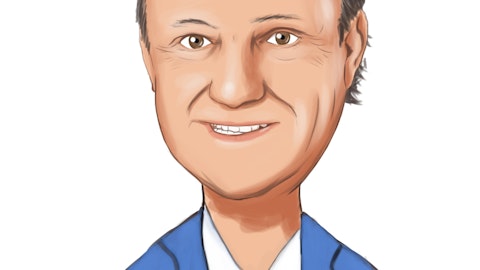Max Michaelis: Okay. And then just shifting to CapEx, I know you mentioned 30% in the maintenance and some other dollars allocated towards facility ramp, just wanted to get a sense of other growth initiatives you guys are may be seeing right now, not existing ones, but new ones that you guys are kind of looking into possible growth areas.
Jana Croom: Yeah, so as I alluded to earlier, we don’t want to be premature in talking about future growth areas or expansion. We really are trying to digest and fully utilize what we have. You know how critical that is in terms of absorption and getting your OI margin where it needs to be. I will also remind everybody, we’re an EVA company. Our incentive compensation is EVA based, so high, high, high focus on ROIC that should give everyone a big sigh of relief in terms of we’re not going to go out and make any dumb acquisitions because we’re too disciplined to that. As Ric said that we do look at upstream manufacturing activities, specifically opportunities with higher-level assemblies with some of our Medical customers and new Medical customers in terms of opportunity there.
The other thing is our investments in automation and technology is really critical, right? It does a couple of things. It allows us to control for the direct labor and you all know what the inflationary environment related to wages has been so that’s critical for us, but it’s also just an expectation of our customers, right? Parts are getting smaller and smaller, the ability to do automated optical inspection, automated placement of parts, et cetera, and so investing in the equipment that allows us to do that is really something that you have to do to stay relevant in a high-quality partner, particularly given that the things that we produce are very difficult to produce to begin with. And so, as you see that higher-level of electronification and electronic content, the investment in automation is really critical.
Max Michaelis: And then just last one for me, just kind of want to get a timing sense of this pullback in the larger medical customer, when did they pull back in the quarter and if you can share what was the contribution in Q4?
Jana Croom: So, we are going to see it begin in Q1 FY ’24.
Max Michaelis: Okay.
Jana Croom: In fiscal ’23, we were partnering with them on the recall. I will point out that we did not play a part in the recall. Our position was to partner with them on correcting equipment so that it could be sent back to customers, that work has completed and there is new production pending the work that they have to do with the FDA and so you will begin to feel it, we will begin to feel it in the first quarter of this fiscal year.
Max Michaelis: Okay, makes sense. Thank you, guys. That’s it from me.
Richard Phillips: Thank you.
Operator: Thanks, Max. Our next question comes from Mike Crawford from B. Riley. Mike, please go ahead with your question.
Mike Crawford: Thank you. I’d like to go back to what Ric was talking about at the beginning of the call about this continuous improvement culture at Kimball, and really the question ties into, and besides things like quality, on-time delivery, speed, market, how do you benchmark versus competitors? And really, I guess the ancillary parts of the question is, in your business you’re constantly giving back say gain margin to the customers where it’s never — I don’t think it’s going to be a 10% operating income business and so how do you balance all of those variables?
Richard Phillips: Sure. Great question. We do try to look at a number of variables. I mean, one benchmark that we track very closely every month relative to competitors is win rate. So as I had mentioned earlier, we’re pretty selective in the programs we go after. We get lots of bid requests. We analyze them, we discuss them with customers, and then when we target them we seek a really high win rate and we’ve been achieving that. So that’s one really important benchmark for us is, what’s our win rate and why do we win, and if we lost why did we lose, and what are we going to do differently? So I think that’s one thing that’s very important. Another one, obviously is, are we outgrowing competitors in each of our verticals? That’s one of the aspirations that we have that obviously means we’re taking share and we feel like we’ve delivered on that significantly in fiscal 2023 and we have that aspiration moving forward.
And then, of course, operating income rate is something that’s near and dear to all of our hearts. As Jana mentioned on the call, we have very little adjustment to what we do, and generally, our GAAP and our adjusted OI rates are right now the same. They’re always very close and I don’t know that that’s the case for all of our competitors. So we try to look at that gap OI rate as a measure of profitability and knowing that to your earlier point, we got to be driving continuous improvement on that to maintain and improve it over time, given the competitive pressures and dynamics with customers.
Mike Crawford: Excellent. Thank you.
Richard Phillips: Thank you.

